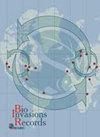Microsporidia are coming: Cucumispora ornata and Dictyocoela berillonum invade Northern Britain
IF 1.5
4区 环境科学与生态学
Q3 BIODIVERSITY CONSERVATION
引用次数: 4
Abstract
Biological invasions are a driving force for biodiversity decline, worldwide. These dynamic systems often include the transference of symbiotic or pathogenic organisms that display their own threat to local fauna. Alternatively, parasites introduced during an invasion can help to control the invasive host population and limit ecological damage. To understand invasion systems that include parasites, it is important to record the presence of invasive parasites as they travel to novel locations. In this study, we screen non-native Dikerogammarus haemobaphes located in Boroughbridge (United Kingdom) for microsporidian parasites, using a PCR diagnostic. We found a prevalence of 9.1% for two microsporidian pathogens: Cucumispora ornata and Dictyocoela berillonum. Genetic data for the two parasites and accompanying haplotype maps are used to determine potential origin and relatedness. Our hapmap for C. ornata indicates two haplotypes of this parasite in the UK, sharing similarities with isolates from Poland and Germany. For D. berillonum , our data concur with recent findings that this parasite does not appear to have high relative genetic variability and shares similarities with isolates across the EU and from multiple hosts. These microsporidian pathogens have a wide host range and pose a risk to surrounding native crustacean fauna. We report the presence of these two parasites in their most northern range and consider their likely origin and connectivity with other isolates across the UK, Europe, and Russia.小孢子虫来了:黄瓜孢子虫和白桦卷叶虫入侵英国北部
生物入侵是全球生物多样性下降的驱动力。这些动态系统通常包括对当地动物群构成威胁的共生或致病生物的转移。另外,在入侵期间引入的寄生虫可以帮助控制入侵宿主种群并限制生态破坏。为了了解包括寄生虫在内的入侵系统,记录入侵寄生虫在新地点的存在是很重要的。在这项研究中,我们使用PCR诊断方法筛选位于Boroughbridge(英国)的非本地Dikerogammarus haemobaphes的微孢子虫寄生虫。我们发现两种微孢子虫病原体的患病率为9.1%:黄瓜孢子虫(Cucumispora ornata)和berillonum Dictyocoela。这两种寄生虫的遗传数据和随附的单倍型图谱被用来确定潜在的起源和亲缘关系。我们对C. ornata的单体型图显示了这种寄生虫在英国的两个单体型,与波兰和德国的分离物有相似之处。对于berillonum,我们的数据与最近的发现一致,即这种寄生虫似乎没有很高的相对遗传变异性,并且与整个欧盟和来自多个宿主的分离株有相似之处。这些微孢子虫病原体具有广泛的寄主范围,并对周围的本地甲壳类动物群构成风险。我们报告了这两种寄生虫在其最北部地区的存在,并考虑了它们可能的起源和与英国、欧洲和俄罗斯其他分离株的联系。
本文章由计算机程序翻译,如有差异,请以英文原文为准。
求助全文
约1分钟内获得全文
求助全文
来源期刊

BioInvasions Records
Environmental Science-Ecology
CiteScore
2.90
自引率
14.30%
发文量
58
审稿时长
16 weeks
期刊介绍:
BioInvasions Records is an Open Access, peer-reviewed international journal focusing on field research of biological invasions in aquatic and terrestrial ecosystems from around the world. It was established in November 2011 as a continuation of the former Aquatic Invasions Records, an electronic supplement of the international journal Aquatic Invasions, with start-up funding from the European Commission Seventh Framework Programme for Research and Technological Development Collaborative Project enviroGRIDS.
BioInvasions Records provides authors with their rights protection concerning primary geo-referenced records, biological monitoring and surveys as well as timely publication of reports concerning first alien species records. This contributes to rapid information dissemination, risk assessment procedures and early warning systems on invasive alien species (IAS).
BioInvasions Records may also contribute to timely and coordinated eradication efforts of newly-found IAS. The fast and comprehensive peer review process of manuscripts serves as an effective quality control mechanism.
The journal provides a forum for professionals involved in research and management of invasive alien species, with focus on new records of non-native species.
BioInvasions Records is an official journal of International Association for Open Knowledge on Invasive Alien Species (INVASIVESNET).
 求助内容:
求助内容: 应助结果提醒方式:
应助结果提醒方式:


